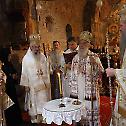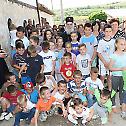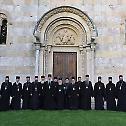Science
Hieromartyr Branko Dobrosavljevic
7. May 2018 - 9:55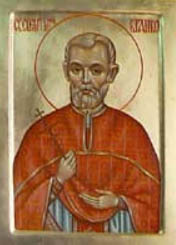 Branko Dobrosavljevic was born in the village of Skadar near Vojnic on January 4, 1886. He completed Grammar school as well as the Seminary in Sremski Karlovci in 1908. He was ordained deacon on March 15, and presbyter on March 22, 1909. He performed his duties in the villages of Buvaca, Radovica and Veljun. Branko received St. Sava's Order and Yugoslav Crown Order of the Fifth Degree. On the Feast of St. George, May 6, 1942, the very day of his own Slava Branko was arrested by the Ustase, headed by Ivan Sajfor from Veljun.
Branko Dobrosavljevic was born in the village of Skadar near Vojnic on January 4, 1886. He completed Grammar school as well as the Seminary in Sremski Karlovci in 1908. He was ordained deacon on March 15, and presbyter on March 22, 1909. He performed his duties in the villages of Buvaca, Radovica and Veljun. Branko received St. Sava's Order and Yugoslav Crown Order of the Fifth Degree. On the Feast of St. George, May 6, 1942, the very day of his own Slava Branko was arrested by the Ustase, headed by Ivan Sajfor from Veljun.
Over 500 Serbs were arrested that day, among them Dimitrije Skorupan, parish priest of Cvijanovic Brdo, and Nebojsa, priest Branko's son. At first they were imprisoned in police station in Veljun, and next day (May 7) they were taken away and killed in the woods called "Kestenovac", near Hrvatski Blagaj. The Ustase forced priest Branko to perform the service for the repose of the soul of the dead to his own son Branko, who was alive at the time. In 1946 priest Branko's martyr relics and the remains of the other killed Serbs were transported to a common grave in Veljun. At the regular session of the Holy Assembly of Bishops of the Serbian Orthodox Church, priest Branko Dobrosavljevic was canonized and his name was entered into the List of Names of the Serbian Church Saints.
The Synaxarion
5. May 2018 - 21:45On the fifth Sunday of Pascha, we celebrate the feast of the Samaritan Woman, the Holy Great Martyr George, the Holy New Martyr Lazarus
Verses
Coming to obtain corruptible water, O woman,Thou drawest living water, wherewith thy soul’s stains thou washest.The Samaritan woman—the holy and glorious Great-martyr Photeini—met Jesus at midday at Jacob’s Well, whichwas located in the city of Sychar. And being tired from travel and the heat, Jesus sat at Jacob’s Well. A little after,the Samaritan woman came to draw water, and had a long conversation with Him (it is the longest recordeddiscourse between Christ and a single person in the entire Bible). Photeini did not want to talk to Jesus, because theSamaritans did not have any dealings with Jews; Jews considered her people heretics because Samaritans kept onlythe first five books of the Old Testament. However, the Lord talked with her anyway, read her heart, revealed hersecrets and gave her to drink of the “Living Water”—the grace of the Holy Spirit that leads to eternal life and flowsto all humanity. Photeini immediately ran throughout the city to proclaim Christ. Through her, many other Samaritans believed in Jesus.
The Holy Great Martyr George
5. May 2018 - 21:43 This glorious and victorious saint was born in Cappadocia, the son of wealthy and virtuous parents. His father suffered for Christ, and his mother then moved to Palestine. When George grew up he entered the military, where he attained, in his twentieth year, the rank of tribune, and as such he was in the service of the Emperor Diocletian.
This glorious and victorious saint was born in Cappadocia, the son of wealthy and virtuous parents. His father suffered for Christ, and his mother then moved to Palestine. When George grew up he entered the military, where he attained, in his twentieth year, the rank of tribune, and as such he was in the service of the Emperor Diocletian.
When Diocletian began his terrible persecution of Christians, George came before him and courageously confessed that he was a Christian. The emperor had him thrown into prison and ordered that his feet be placed in stocks and that a heavy stone be placed on his chest. After that, the emperor commanded that George be tied to a wheel, under which was a board with large nails, and he was to be rotated until his whole body became as one bloody wound. After that, they buried him in a pit with only his head showing above the ground, and there they left him for three days and three nights. Then George was given a deadly poison to drink by a magician. But through all of these sufferings, George continuously prayed to God, and God healed him instantly and saved him from death, to the great astonishment of the people. When he also resurrected a dead man through his prayers, many accepted the Christian Faith. Among these were Alexandra, the wife of the Emperor Diocletian; the chief pagan priest; the farmer Glycerius; and Valerius, Donatus and Therinus. Finally, the emperor commanded that George and his own wife Alexandra be beheaded. Blessed Alexandra died on the scaffold before being beheaded, and St. George was beheaded in the year 303 A.D. The miracles which have occurred over the grave of St. George are countless. Numerous are his appearances, both in dreams and openly, to those who, from that time to today, have invoked him and implored his help. Inflamed with love for Christ the Lord, it was not difficult for this saintly George, for the sake of this love, to leave all: rank, wealth, imperial honor, his friends and the entire world. For this love, the Lord rewarded him with a wealth of unfading glory in heaven and on earth, and with eternal life in His kingdom. In addition, the Lord bestowed upon him the power and authority to assist all those in afflictions and difficulties who honor him and call upon his name.
Second Day of the session of the Holy Assembly of Bishops
1. May 2018 - 13:43On 30 April 2018, His Holiness Irinej, Serbian Patriarch, officiated the Holy Hierarchal Liturgy at the Pec Patriarchate, after which he chaired the session of the Holy Assembly of Bishops.
On the second day of the session of the Holy Assembly of Bishops of the Serbian Orthodox Church, following the Eucharist gathering which was officiated by Serbian Patriarch Irinej with concelebration of the Bishops: Jovan of Sumadija, Joanikije of Budimlje-Niksic and David of Krusevac, the gathered Hierarchs visited the Serbian village of Velika Hoca and monasteries of Zociste and Dechani. We recommend to our website visitors to see the photographs of our tireless coworker deacon Dragan Tanasijevic:
Hieromartyr Simeon the Bishop in Persia, and those with him in Persia
27. April 2018 - 13:37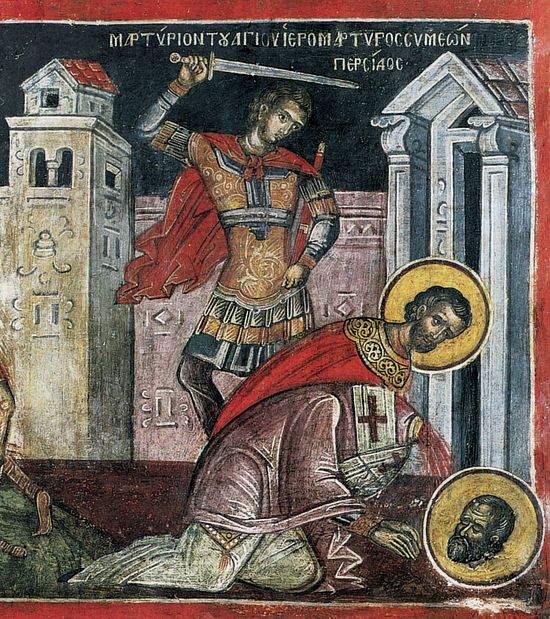 The Hieromartyr Simeon, Bishop of Persia, suffered during a persecution against Christians under the Persian emperor Sapor II (310-381). They accused the saint of collaborating with the Roman Empire and of subversive activities against the Persian emperor.
The Hieromartyr Simeon, Bishop of Persia, suffered during a persecution against Christians under the Persian emperor Sapor II (310-381). They accused the saint of collaborating with the Roman Empire and of subversive activities against the Persian emperor.
In the year 344, the emperor issued an edict which imposed a heavy tax upon Christians. When some of them refused to pay it, this was regarded as an act of rebellion, so the emperor began a fierce persecution against Christians.
Saint Simeon was brought to trial in iron fetters as a supposed enemy of the Persian realm, together with the two hieromartyrs Habdelai and Ananias. The holy bishop would not even bow to the emperor, who asked why he would not show him the proper respect. The saint answered, “Formerly, I bowed because of your rank, but now, when you ask me to renounce my God and abandon my faith, it is not proper for me to bow to you.”
The Church in Seventh Century Celtic Britain
26. April 2018 - 13:12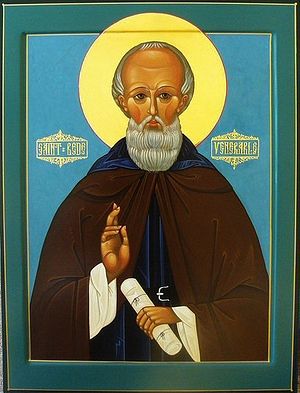 In the seventh century A.D., the population of Britain consisted mainly of two ethnic groups relatively equal in number, collectively known as the Celts and the Anglo-Saxons respectively. The Celts can be divided into three major sub-groups, namely the Welsh (the descendants of the Britons—the native inhabitants of Britain who were driven west by the invading Angles and Saxons) in Wales; the Picts (an indigenous tribal confederation of peoples in Scotland); and the Fenians, or Scots (a Gaelic people that migrated from Ireland to Scotland around the late fifth century)—this is how they were commonly called in Britain (“Scotti”, meaning “wanderers”, referred to the Irish in general). The name “Scotland” derives from the Latin “Scotia”—“the land of the Scots”. This is because in the middle ages, Scotland as a country was developed by the Scots rather than the native Picts.
In the seventh century A.D., the population of Britain consisted mainly of two ethnic groups relatively equal in number, collectively known as the Celts and the Anglo-Saxons respectively. The Celts can be divided into three major sub-groups, namely the Welsh (the descendants of the Britons—the native inhabitants of Britain who were driven west by the invading Angles and Saxons) in Wales; the Picts (an indigenous tribal confederation of peoples in Scotland); and the Fenians, or Scots (a Gaelic people that migrated from Ireland to Scotland around the late fifth century)—this is how they were commonly called in Britain (“Scotti”, meaning “wanderers”, referred to the Irish in general). The name “Scotland” derives from the Latin “Scotia”—“the land of the Scots”. This is because in the middle ages, Scotland as a country was developed by the Scots rather than the native Picts.

